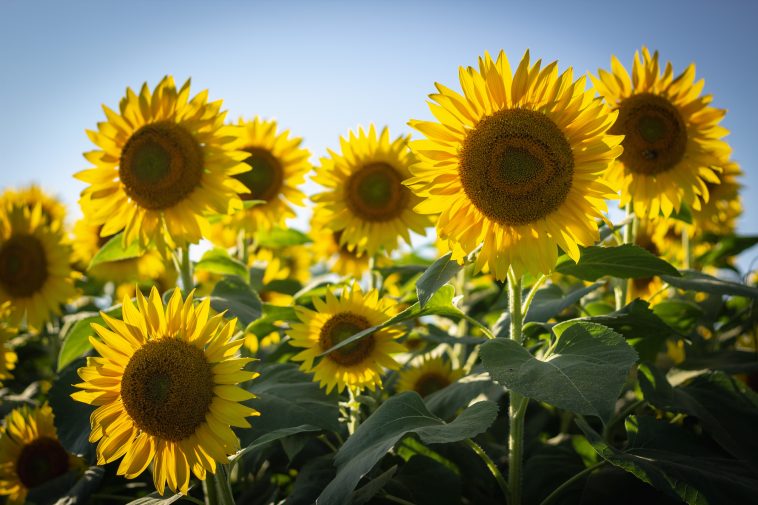The sunflower, Helianthus annus L., is one of the few crop species that can be traced back to North America, despite reports that it originated in the Fertile Crescent, Asia, or in South or Central America. Most likely, it was used as a “camp flower” by several western Native American tribes (North American Indians) when they domesticated the crop, speculated to be around 1000 BC, and then they possibly spread it to the east and south of North America.
It is believed that sunflower cultivation was first observed by the Europeans in a variety of locations, ranging from southern Canada to Mexico and Spain.
Sunflowers were probably introduced to Europe through Spain and then spread throughout Europe until they reached Russia, where the flower was able to easily adapt to its new environment.
Selection for high oil content in Russia began in 1860, and it was largely responsible for increasing oil content from 28 percent to nearly 50 percent over the course of the next century.
After World War II, the high-oil lines from Russia were reintroduced into the United States, rekindling interest in the crop.
Agronomic requirements
Soil requirements
Sunflower is produced in a wide range of fertile soil types, from sandy loam to clay, with pH values ranging from 6,0 to 7,5. Sunflower has a low tolerance to salt. Sunflower production necessitates good soil drainage, but this crop does not differ significantly from other field crops in terms of flood tolerance. Under dryland conditions, soils with a high water-holding capacity (clay soil) will be ideal over other types of soils.
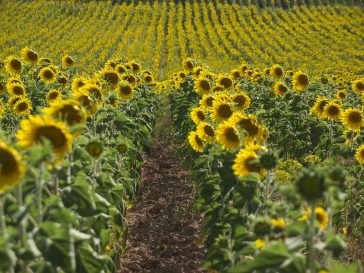
Rows of sunflowers in cultivated land.
Climate requirements
The plant tolerates both low and high temperatures, with low temperatures being the most tolerable. During rising temperatures, the crop is particularly sensitive to high soil temperatures.
Sunflower seeds germinate at temperatures as low as 5 degrees Celsius, but temperatures between 14 and 21 degrees Celsius provide satisfactory germination. Even though the optimal temperature for growth is between 23 and 28 degrees Celsius, a wider range of temperatures up to 34 degrees Celsius has little negative impact on productivity. Extremely high temperatures have been shown to reduce oil percentage, seed fill, and germination.
Rainfall
Rainfall requirements range from 500 to 1 000 millimetres. When compared
to other crops, the crop performs exceptionally well during drought conditions. Although the crop is not considered to be particularly drought tolerant, it frequently produces satisfactory results while other crops are severely damaged by drought.
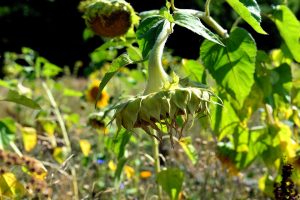
Maturing of sunflower heads.
Cultural practises
Propagation
Sunflowers are propagated by seed.
Soil preparation
Especially in soils with a low infiltration rate, soil preparation should be focused on reducing runoff to the greatest extent possible. The application of proper soil cultivation practises can significantly reduce these losses. Seedbed preparation systems such as mouldboard ploughing and chisel ploughing are traditional methods of seedbed preparation that are used to incorporate residue and perform several secondary field operations. Potassium and nitrogen availability and distribution have both been shown to improve with conventional systems, a well as an increase in the temperature of the seed zone.
Planting
The yield potential of the area will dictate the planting density for sunflowers, which ranges from 25 000 to 35 000 plants per hectare, depending on the variety. Row widths can range from 90 to 100 centimetres, but wider rows can also be used, particularly to accommodate other managerial aspects of crop production. When planting seeds at a depth of 5 to 8 cm, the required spacing in the row is approximately 30 cm. Sunflowers are planted in Southern Africa from the beginning of November until the end of December in the eastern areas, and from the beginning of January until the middle of January in the western areas.
Fertilisation
To obtain a reliable indication of the soil fertility status, soil samples should be collected well in advance of planting and then analysed. According to research, sunflowers respond to the nutrients N, P, and K. Nitrogen deficiency is a common problem in nonleguminous grain crops, and it is often the first factor to constrain yield.
Although yield increases with N fertiliser rates of up to >120 kg/ha have been observed, N fertiliser rates significantly lower than this are usually recommended, particularly in dryland farming. In soils that contain a high concentration of nitrogen, low nitrogen applications should be made. Nitrogen can be supplied from mineral or nonmineral sources (manures, legumes, compost).
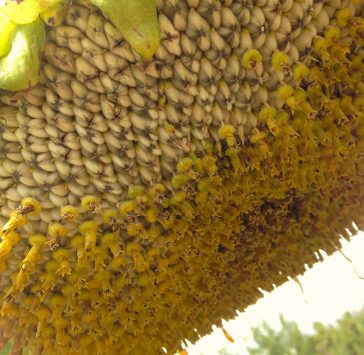
Developing sunflower seeds and flowers.
As is the case with many species, the placement of P and K in the rows of sunflowers may be critical to maximising the efficiency of fertiliser application.
Following soil sampling, fertiliser recommendations should be made by the agronomist.
Irrigation
Sunflowers are cultivated under dryland conditions in most cases in Southern Africa during the summer rainfall season (November to March). In areas where rainfall is insufficient, irrigation can be used as a supplement to increase yield. The method of irrigation will be determined by the availability of water as well as irrigation equipment. The pH of irrigation water should be neutral.
Weed control is important
Weed control during the growing season is critical for good yields. A combination of cultural (mulching, rotation, intercropping, use of cover crops, deep tillage) and chemical methods should be used to achieve successful weed control.
Post-emergence cultivation with a coilspring harrow, spike tooth harrow, or rotary hoe is possible when sunflowers are in the four to six leaf stage (beyond the cotyledon) with as little as 5 to 7 percent stand loss. This is best done on dry afternoons when the plants are less turgid.
Annual (purple and yellow nutsedge) and perennial grasses are some of the most common broad-leaved weeds. It is recommended to use registered chemicals.
Pest control is important
In sunflower growing areas, insect pests are significant potential yield-reducing factors. The use of integrated pest management (IPM) practises by growers is required due to potential risks.
Seed coats of resistant plants have the presence of a dark-coloured “armour” layer that demonstrates their insect resistance. The development of midge resistance has been suggested, but it is not currently effective.
Only insecticides that prove effective in the field should be used for insect control.
Birds (blackbirds, goldfinch, dove, grosbeak, and sparrow) can be serious pests on sunflowers and particularly destructive. Scarecrows, fright owls, fluttering aluminium strips, and carbide exploders are some methods tried to disrupt feeding behaviour in birds.
Crop rotation, the use of resistant cultivars, and the use of certified seeds are all examples of cultural control measures.
Disease prevention and control
Fungi are responsible for the most serious diseases that affect sunflowers. Rust, downy mildew, verticillium wilt, sclerotinia stalk and head rot, and phoma black stem and leaf spot are some of the serious diseases. It is recommended to use registered chemicals.
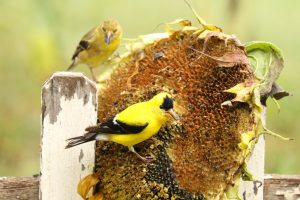
Wild bird eating sunflower seeds.
Other disease control mechanisms
Crop rotation, conservation tillage, scheduled irrigation, and the use of disease-resistant cultivars.
Harvest maturity and methods
Harvesting should begin once 80 percent of the sunflower heads are brown to reduce losses due to birds, lodging, and shattering. When the heads are mature, they turn yellowish. The sunflower plant has reached physiological maturity when the back of the head has turned from green to yellow and the bracts have turned brown, which occurs approximately 30 to 45 days after bloom and when the seed moisture content is approximately 35 percent.
In general, the growing period for sunflowers (from seeding to harvesting) is between 125 and 130 days.
Harvesting can be done by hand or by machine, depending on the situation. Manual harvesting is done by cutting the crop with a sickle or a knife.
Sunflower headers, which are readily available on the market, are useful in reducing seed loss when the crop is directly combined. The combine harvester is used to perform a variety of tasks, including cutting the crop, separating grain from straw, cleaning grain from chaff, and transporting grain to a storage tank.

Sunflower seeds.
Uses of sunflowers
Human uses: Sunflower can be used as an edible oil in the form of margarine, salad dressing oil, cooking oil, and snack foods.
Animal feed: Sunflower meal, whether dehusked or partially dehusked, can be used for ruminant animals, pig rations, poultry feeds, and silage.
Industrial uses: Sunflowers can be found in a variety of paints, varnishes, and plastics, as well as in the production of soaps and detergents. Other industrial applications include the production of agrichemicals, the use of pesticides, surfactants, adhesives, fabric softeners, lubricants, and coatings. Because of the high potential for use in diesel engines in the future, farmers can contribute to achieve a pollution-free environment.
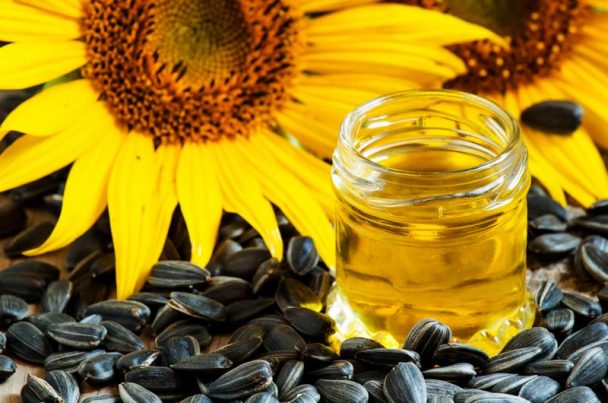
Sunflower seed oil.
The information provided in this article is credited to the South African Department of Agriculture, Forestry and Fisheries. For more information, visit their website at www.daff.gov.za, contact them on +27(0)12-319-6072 or send an e-mail to DPP@nda.agric.za.

